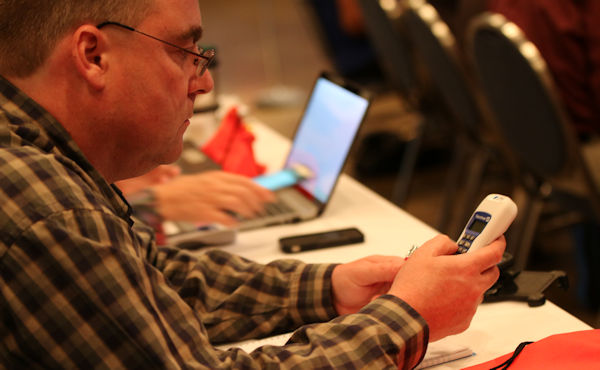The North Central Jurisdictional Conference used electronic voting for the first time in 2016. The hand-held devices proved to be a blessing.
LEINTZ BELONY
Indiana UMC Communications
Indiana UMC Communications
PEORIA — Introduced officially at the 2016 Jurisdictional Conference held in Peoria Ill., handheld electronic voting devices have made plenary voting a much faster, simpler, and efficient process designed to help significantly reduce the time and alleviate stress in between ballots.
As the legislative body of the twelfth North Central Jurisdictional Conference gathered at the Peoria Civic Center in Peoria, Ill., it was expected that some things would be different in comparison to the previous episcopal election of 2008. Though it soon became apparent that with the implementation of electronic voting systems to elect leaders of The United Methodist Church, the selection process would experience a dramatic shift in dynamic.
In previous elections, breaks would have to be allotted after each balloting session to allow for votes to be counted and results to be updated. For episcopal nominees and delegates, this was the perfect occasion to connect with peers, discuss strategy, and draw potential balloting outcomes. But ultimately, this made the selection process unnecessarily long and arduous.
Matthew Bader, a 21 year-old delegate of the Dakotas Conference, stated that the shortened turnaround time is one of the elements he appreciates most about the electronic voting process. “You don’t have to wait, break for 30 minutes and then come back for the results.” Electronic votes can be gleaned and posted live within minutes, minimizing lag time considerably. Bader, who attended the 2016 General Conference, noticed the change in turnaround time there as well.
As the legislative body of the twelfth North Central Jurisdictional Conference gathered at the Peoria Civic Center in Peoria, Ill., it was expected that some things would be different in comparison to the previous episcopal election of 2008. Though it soon became apparent that with the implementation of electronic voting systems to elect leaders of The United Methodist Church, the selection process would experience a dramatic shift in dynamic.
In previous elections, breaks would have to be allotted after each balloting session to allow for votes to be counted and results to be updated. For episcopal nominees and delegates, this was the perfect occasion to connect with peers, discuss strategy, and draw potential balloting outcomes. But ultimately, this made the selection process unnecessarily long and arduous.
Matthew Bader, a 21 year-old delegate of the Dakotas Conference, stated that the shortened turnaround time is one of the elements he appreciates most about the electronic voting process. “You don’t have to wait, break for 30 minutes and then come back for the results.” Electronic votes can be gleaned and posted live within minutes, minimizing lag time considerably. Bader, who attended the 2016 General Conference, noticed the change in turnaround time there as well.
“I appreciate its clarity, its expediency, and the fact that it allows us to be good stewards of our time.” claims Rebecca Treftz, Director of Ministries, Dakotas United Methodist Conference. On mechanics — Rebecca appreciates the user-friendly features of the electronic voting handheld, stating that it’s easy to manage, reliable in terms of accurate results, and flexible, allowing users to correct their errors discreetly.
Paul White, Secretary of the NCJ, advised that, so far, he’s received encouraging feedback regarding the new voting system, and that it has worked very well as well as helped move the process along. In regards to no longer having any lag time between ballots, White says that with strategized changes to the schedule they’ve been able to accommodate a happy medium for the Jurisdictional voting body. In reference to applying this same voting standard to the 2020 Jurisdictional Conference set to take place in Indiana, White states, “that depends largely on the organizing committee, we know that Indiana has used a similar system, but we’ll have to gauge their preferences and decide what works best for the voting body.”
Technology as a whole has rapidly become a centerpiece of UM Conferences and gatherings, from social media and mobile networking, to live streaming, text updates, and even Slack, an internal communications tool designed to support proactive, team-focused conversations. Needless to say, the ways in which United Methodist organizations communicate with members and the outside world, have changed dramatically.
Last Updated on July 15, 2016

